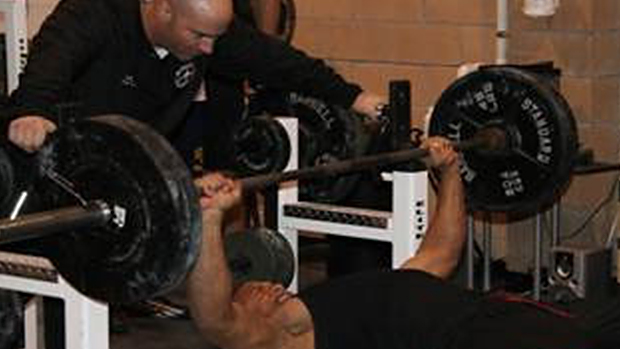Has your bench press been stuck for a while?
Been shooting for three plates for what seems like forever, but
just can't seem to get there?
Take heart. All good lifters get stuck on a plateau every so
often, and while it can be frustrating, it doesn't have to be
insurmountable. Here's a six-week program for busting through the
most stubborn plateau. I call it the Plateau
Breaker.
This program is geared specifically toward the bench press, but
the concepts can be applied to any lift. It's designed for
intermediate or advanced level lifters (because if you're a
beginner, then you shouldn't be hitting any plateaus
yet).
The principles of this program are pretty simple. The two best
ways to build maximum strength are the maximum effort method
and the repetitive effort method, so that's what we'll be
focusing on. You also need a lot of hard work (no shortage of that
here), coupled with adequate rest to allow the body to recover.
Since you will be hitting the chest specifically only once a
week on this program, you'll get enough rest and you'll
need it. Finally it's been suggested that regular heavy training
with the same exercise can lead to CNS burnout after 4 weeks, so we
have some necessary variety in the program as well.
Here's what I want you to do: first, we need to know how much
you can actually bench, so we'll have a test week. On Monday (or
whichever day you train bench the heaviest), go in and find your
max on the bench press. Obviously, you should use a spot, but don't
count the lift if your form goes to hell, or if your spotter
touches the bar. Then train as normal for the rest of that week
(but don't train your chest again). Starting the following week,
for the next six weeks, follow the Plateau Breaker program
outlined below.
| Week 1: Maximal Effort Week | Week 2: Repetitive Effort Week | ||||
|
Exercise |
Sets |
Reps |
Exercise |
Sets |
Reps |
|
Bench press |
5 |
3-5 |
Bench press |
3 |
12-20 |
|
Incline bench press |
5 |
3-5 |
Incline bench press |
3 |
12-20 |
|
Close grip bench press |
5 |
3-5 |
Close grip bench press |
3 |
12-20 |
|
Cable crossover |
5 |
5-8 |
Cable crossover |
3 |
15-25 |
| Week 3: Maximal Effort Week |
Week 4: Repetitive Effort Week |
||||
|
Exercise |
Sets |
Reps |
Exercise |
Sets |
Reps |
|
Bench press |
5 |
3-5 |
Bench press |
3 |
12-20 |
|
Decline bench |
5 |
3-5 |
Decline bench |
3 |
12-20 |
|
Hammer Strength |
5 |
3-8 |
Hammer Strength |
3 |
12-20 |
|
Board press |
5 |
1-5 |
Board press |
3 |
12-20 |
| Week 5: Maximal Effort Week |
Week 6: Repetitive Effort Week |
||||
|
Exercise |
Sets |
Reps |
Exercise |
Sets |
Reps |
|
Floor press |
5 |
3-5 |
Floor press |
3 |
12-20 |
|
Dumbbell press |
5 |
3-5 |
Dumbbell press |
3 |
12-20 |
|
Dumbbell fly |
5 |
5-8 |
Dumbbell fly |
3 |
15-25 |
|
Pause bench |
5 |
3-5 |
Pause bench |
3 |
12-20 |
As previously mentioned, this program is designed to be followed
on a once a week split. A good split that works well with this
setup is:
|
Day 1 |
Day 2 |
Day 3 |
Day 4 |
Day 5 |
Day 6 & 7 |
|
Chest |
Back |
Cardio |
Legs |
Shoulders |
Rest |
|
Abs |
Biceps |
Rest |
Lower Back |
Triceps |
You can flip either days 1 and 2 or days 4 and 5
if you prefer (not both of them), but since we're focusing on chest
for 6 weeks, train it when you're fresh and feeling good. You can
do abs more than once a week if you want.
The exercises listed are in the order they need to be performed,
so don't change the order. Here's a quick explanation on some
exercises that might be confusing:
Bench press
You're probably saying, "well, duh." Yes, I know you know this exercise, but bear with me. It's the cornerstone of
this program, so I want to make sure we're all doing it properly.
Grip the bar wider than shoulder width, so that your forearms
are perpendicular to the bar at the bottom of the range of motion.
If you already have a grip you love, go with it. Touch your chest
on the lower half of the sternum. Nipple level works well.
Keep your elbows tucked 45-60 degrees on the way down, and on
the beginning part of the way up. Slightly arc the bar back up
toward your head as you press, particularly with the heavy weight
and lower rep sets. Your butt, head and feet don't move during the
set. A little arch in the lower back is fine if it works for
you.
Close grip bench press
Don't grip it tooclose: keep your hands just outside of
the chest at the bottom. I find that putting two fingers on the
smooth part of the bar and two fingers on the grip (knurling) works
very well for almost everybody. Keep your elbows
tucked.
Cable crossover
Like a fly, but you start with your hands shoulder height, then
bring them down in front of your waist.

Start position

End
position
Hammer Strength incline
If you don't have access to this machine, you can substitute
another incline machine that you like, or else do incline dumbbell
presses.
Board press
Use two or three boards (two if you're weak near the bottom,
three for everybody else). If you don't have boards, you can use a
yoga block, a foam roller, or some 25-pound weights. In a pinch you
can use a rack and do rack presses, but you really should get some
boards, they're very useful and easy to make.

Board press using three boards.


Variations using yoga block and foam
roller.


Homemade board press boards.
Floor press
This is simply a bench press performed on the floor, which
limits your range of motion. Use about as much or more weight for
this exercise as you do for the bench press.


When doing the floor press without a power rack, you can
"rack" the weight on the end of a bench.
Pause bench press
Perform a normal bench press, but include a distinct pause on
the chest for each rep, just like in an actual powerlifting
competition. Count to yourself "one thousand one" (or "one
Mississippi," or "one Jamie Eason" or whatever) with the bar on
your chest and then press, doing this for each rep. Since this
comes at the end of the workout and you may not be used to it, your
weight will be down significantly, perhaps as much as 20% lower.
The other reps are all touch and go.
The sets listed are work sets: we're assuming that you'll do 2
to 4 warm-ups sets on the first exercise of the day and 1-3 warm-up
sets for every other exercise.
On the max effort days you can do sets across (the same weight
for each work set like 275 x 5 x 5) or you can do ascending sets
(i.e. 255 x 5, 265 x 5, 275 x 5, 285 x 5, 295 x 5), whichever
you prefer. I generally prefer the ascending set style, especially
on the first exercise.
On the repetitive effort days you can do sets across if you can
manage it (often the weight stays the same but the reps drop like
225 x 20, 225 x 16, 225 x 12) or you can do descending sets where
the weight decreases each set (i.e. 225 x 20, 205 x 20, 185 x 20).
If you can't get the minimum number of reps listed on either day,
the weight needs to be decreased.
When you repeat the bench press on weeks 3 and 4 try to use more
weight than you did on weeks 1 and 2 (increase 2.5 to 10 pounds).
So if you finished with 275 x 5 on week 1, try 280 x 5 on week 3.
This program is pretty brutal, so be prepared. On weeks 1, 3,
and 5 you'll be going pretty heavy for a good number of exercises,
and on weeks 2, 4, 6 you'll probably be doing a lot more reps than
you're used to. You'll most likely get a huge pump in your
chest (like someone is trying to blow air into the muscle; it feels
fantastic!).
You may notice the weight you're lifting drop off a lot on the
latter exercises, but don't sweat it. What this means is that
you've fatigued the muscle, which is exactly what we're after.
Don't let your ego get involved and lift heavy without doing the
amount of recommended reps on the rep effort days.
Make sure your rest periods on the max effort days are as long
as you need: 2-5 minutes usually works well. On the rep effort
days, keep the rest under 3 minutes. These workouts will usually
take about 60-90 minutes to complete.
Don't test your one-rep max again for any reason during this
program. Once you've completed the plan, then you'll do
another test week.
The week after you finish week 6, come in and max out again on
the same day that you've been doing chest. Follow the same
procedure that you used to find your one-rep max earlier, but this
time, instead of just repeating your max, add 5 pounds to it. If
you're successful, congratulations, you just set a new PR! If you
have some strength still left in the tank, throw on another 5-10
pounds and try it again.
I'm not going to bullshit you and say you should expect to add
50 pounds to your bench in 6 weeks with this program. If you're
intermediate or advanced, and on a true plateau, you already know
that's practically impossible. But the vast majority of people
who follow this routine add an honest 5-10 pounds to their bench,
and I've had a few people add 20 pounds to it.
This routine isn't designed to be followed indefinitely.
Once you do it for the recommended 6 weeks, follow another program
for a while and wait at least 3 months before you come back and try
it again. Each time, test your one-rep max before you start and
after you finish so you'll know for sure what actually
happened to you. Good luck with it. If you have any questions about
the program, post them in the discussions section and I'll try to
answer them there.




